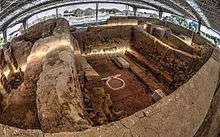Cancho Roano
Cancho Roano (sometimes Cancho Ruano) is an archaeological site located in the municipality of Zalamea de la Serena, in the province of Badajoz, Spain. Is located three miles from Zalamea de la Serena in the direction of Quintana de la Serena Quintana, in a small valley along the stream Cagancha.

Cancho Roano is the best preserved Tartessian site. It dates back to at least the sixth century BCE, although the building was expanded and modified in later centuries. Based on the dating of objects found on the site, Cancho Roano is estimated to date from 550 BCE. The site was destroyed in a fire no later than 370 BCE. The building appears to have been ritually burned and sealed in rammed earth in a manner similar to Etruscan ceremonies.[1]

The main body of the building is square and oriented toward the east. The building is surrounded by a deep moat, which was permanently filled with water. Although Cancho Roano's exact function is unknown, the religious character of the site is undeniable due to the presence of altars; however, the site may be a palace-shrine, judging from its defensive system.
Excavations of the site, directed by John Maluquer de Motes, began in 1978 and continued through 2001. It was declared a National Monument in 1986. The site, along with an interpretation center, is open to the public.
Richard Freund theorizes that Cancho Roano was a "memorial city" designed to serve as a ceremonial representation of the lost city of Tartessos, which, in Freund's theory, was also Atlantis. Freund argued that a stele found at Cancho Roano displayed an image with concentric circles that matches Plato's description of Atlantis.[2] Nonetheless, Freund’s theories have been widely dismissed in academic circles, and the symbol is not much more than a typical warrior shield engraved in the Southwestern Stelae from the Iberian Peninsula, of which there are many examples.[3]
References
- José María Blázquez Martíne. "El santuario de Cancho Roano." Antigua: Historia y Arqueología de las civilizaciones. 1999. http://descargas.cervantesvirtual.com/servlet/SirveObras/antig/01715418104585090770035/014454.pdf?incr=1. p. 85.
- Martin Barillas. "If the Fabled Atlantis Was Destroyed by a Tsunami, Has it Finally Yielded its Secrets." Cutting Edge News. 14 March 2011. http://www.thecuttingedgenews.com/index.php?article=32114&pageid=28&pagename=Sci-Tech
- Hernando Grande, Amparo: "Representaciones del escudo en la Península Ibérica: escudos en estelas" CuPAUAM: Cuadernos de Prehistoria y Arqueología 3 (1976): 127-135 http://hdl.handle.net/10486/616
External links
- All about Cancho Roano (web del C.S.I.C.) (in Spanish)
- El Santuario de Cancho Roano (in Spanish)
- Museo de Cancho Roano (in Spanish)
- Cancho Roano como monumento proto-histórico (documento PDF) (in Spanish)